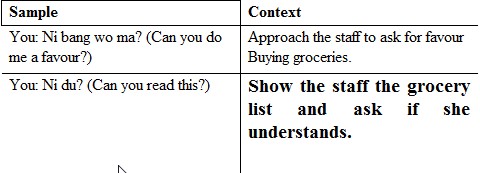If you have just arrived here, do read, Observing Language Development first.
This is how I learn my 5th language. No dictionary, no translator, just work with the environment straight away. I use a specific example, grocery shopping.
I used to keep a record of all the grocery list and receipts, and the domestic staff kept a log of the household spending as well. Because they do not write in English, it became another source of language learning.
Pick a time to record at least 25 utterances using the following format . The native language is written in brackets. Write the non-native language is exactly the same way as you utter or say, and write all the words as they sound. For example, a non-native English may spell bread as bred.

Show the staff the grocery list and ask if she understands.
When you are free, examine the data you have collected to see the pattern that has emerged.
Here are some tips:
-
Pronunciation
Which sounds do you have difficult pronouncing or which word do you not know how to say? Mark on the paper on how it is suppose to sound like and learn to say the word again properly.
-
Semantics
This means to check if you are using the correct word to describe what you mean. This is tricky as sometimes, you use the native language and translate, found the word, say it incorrectly and gives the word a totally different meaning altogether. The word ‘water’ for example is ‘air’ in Bahasa Indonesia but it is not pronounced as ‘air’ as the air you breathe. It is ‘aeyr’.
-
Grammar
How have you ordered your words in your sentences?
Do you see irregularities and anything unusual in the construction of your sentence?
Did you attempt to put in grammatical rules properly without overgeneralising?
How many words do you use in the sentence?
Do you try to hard – repeating each word that is already understood?
-
Pragmatics>
You may speak differently when you speak to another foreigner. Take note of all the changes in modulations and articulations of the languages.


It is very interesting the way you have been observing language development.
I also speak four languages (I think most people in Asia can speak at least two languages)
I have heard that when learning a new language it is best not to try to translate from a known language to it. Rather one should start from scratch as a child does and slowly build up our vocabulary. Do you think that is the right way?
The steps you have laid out seem like the perfect way of learning a new language.